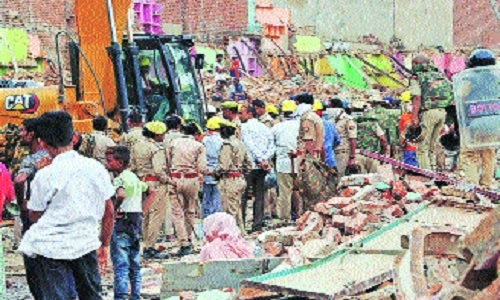LAND ACQUISITION IS POSING PROBLEM FOR INDIA’S INFRASTRUCTURE GROWTH
| Date :23-Aug-2023 |

NANTOO BANERJEE
The sight of slums, or jhuggis’, along railway tracks is common in the country. The Surat- Udhana to Jalgaon railway line project in Gujarat has remained incomplete due to unauthorised structures on railway property for at least 2.65 km, said the Supreme Court in December 2021.
LAST week’s Supreme Court order to temporarily stay the demolition drive of the Railways to clear “encroachment” near Krishna Janmasthan in Mathura could be a matter of concern for both the railways and 135-family dwellings on the Government land. Neither the Railways nor the dwellers on the original Railway land are sure about the final direction of the Supreme Court order. Not long ago, the Delhi High Court directed the North Delhi Municipal Corporation and Archaeological Survey of India to ensure that no further illegal construction takes place around Jama Masjid and the Walled City area of Old Delhi in response to a petition filed by Civilian Welfare Charitable Trust before the court. The trust alleged rampant illegal constructions and encroachments around Jama Masjid, Turkman Gate, Kashmere Gate and Ajmeri Gate but authorities failed to act against the violations.
“The ASI in abdication of its statutory functions to protect and maintain the monuments and heritage properties under the Ancient Monuments and Preservation Act is maintaining astoic silence over continued illegal construction that is taking place in and around the city,” read the petition.
The case surrounding the alleged “encroachment” of the railway land in Mathura may have attracted a national public audience as the dwellers belonged to a religious community.
The railways, defence, highway authorities and the State And Central Governments are constantly fighting to reclaim their land holdings from illegal encroachers to expand development works. Several popular railway stations, their approach roads, highways in city intersections, and major religious institutions are substantially encroached upon by illegal settlers using them as business avenues and dwellings. Such illegally occupied areas, running into lakhs of acres of land, are stalling the expansion and development activities by various State agencies across the country. The encroachers are normally backed by political parties, religious institutions and their agents and even private protection forces with deep connection with the police and administration. The matter is serious as hundreds of such cases of illegal occupation, constructions and settlements in government as well as private lands are pending before the courts of law for years stalling the development projects in the country while fresh land acquisition by the Government is becoming increasingly difficult and time consuming. In a written reply to Rajya Sabha, Railway Minister Ashwini Vaishnaw lately stated that of the upto 4.86 lakh hectares of land that the Railways owns, 782 hectares are encroached upon and that in 2022–23 only around 6.84 hectares of land could be retrieved. Earlier, the Ministry of Defence had received reports from the department’s land management agencies that approximately 10,126 acres of defence land are under encroachment.
From the Mumbai-Ahmedabad bullet train project to Kerala’s SilverLine rail corridor, encroachment has become a multi-pronged issue in India where illegal structures have cropped up alongside railway tracks in most cities and towns. The railway authorities claim to have 29 acres of land under encroachment in Uttarakhand’s Haldwani, where close to 50,000 people were directed to be “removed” by the high court. The eviction order, stayed by the Supreme Court, gave relief to over 4,000 families, a majority of them Muslims, that reside on disputed land. The families, however, assert that they are the rightful owners of the land as they have been residing on it for over 50 years.
The question is: what were the Indian Railways doing when the land was first grabbed by the “encroachers” and in the subsequent years.
The sight of slums, or jhuggis’, along railway tracks is common in the country. The Surat- Udhana to Jalgaon railway line project in Gujarat has remained incomplete due to unauthorised structures on railway property for at least 2.65 km, said the Supreme Court in December 2021, while hearing pleas raised against issues related to removal of encroachment from railway land in Gujarat and Haryana. The top court was also hearing a plea related to demolition of ‘jhuggis’ on railway tracks in Faridabad.
In the Gujarat matter, 5,000 ‘jhuggis’ have to be demolished in order for the railway line project to come up. For the Mumbai-Ahmedabad bullet train project, the Gujarat Government and the railway authorities had first attempted to evict the residents of the slum dwellings at the Sabarmati area in 2018. The residents have claimed that they have been living in the area since 1991 with migrants from different districts coming in, and that the population had grown at some 70 slum dwellings over the years.
Among several large infrastructure projects facing uphill tasks to complete in the face of illegal land occupation by people under strong political and religious patronage is the Western Dedicated Freight Corridor, a special railway project covering over 1,483 km from Jawaharlal Nehru Port Trust to Dadri in Haryana. Several railway expansion and reconstruction projects in the Maharashtra region are hit by unauthorised structures built on the railway land. In the Mumbai division alone, 24,500 unauthorised structures, occupying 57 hectares of land, exist on the Central Railways’ Kurla, Mankhurd, Trombay lines and the Bandra-Khar belt. In 2020, the Bombay High Court said the railways cannot acquire land without arranging for compensation and rehabilitation.
Dealing with land acquisition — from legal or illegal occupiers — is posing as the single biggest hindrance to India’s attempt to speedy implementation of infrastructure projects to ensure higher economic growth and human development. Land acquisition cases are taking too long for judicial resolutions. Court judgements on such cases are often contradictory and evictions become increasingly difficult to conduct.